On a recent Friday afternoon Choup Leakhena, 18, was wondering around Phnom Penh’s National Museum, taking selfies with some of the institution’s impressive—and growing—collection of ancient Khmer sculpture.
A freshman at Pannasastra University who hails from Takmao city in Kandal province, Leakhena told VOA Khmer that the beauty of the works gave her a sense of national pride.
“I love and appreciate these masterpieces, such as the apsara”—a celestial nymph from Hindu mythology—“the statues of [12th century Khmer monarch] Jayavarman VII, Vishnu and Buddha,” she said. “I am able to see into life in the past.”
Artifacts looted from Cambodia’s ancient temples during decades of conflict have started to flow back into the country, giving young Cambodians like Leakhena an opportunity to embrace the country’s cultural heritage and history.
“I came here because I want to learn about it,” she said. “Finally, I can see [the sculptures] and I can admire our Khmer ancestors, who created such precious pieces for us. It’s really unique. Other countries don’t have such amazing artworks.”
In a remarkably successful campaign in recent years, the Cambodian government has identified looted artifacts abroad and initiated legal efforts to reclaim them. And the tide appears to have turned, with many of the treasures spirited away and sold on the black market now finding their way back to the nation that made them.
In June 2014 three statues were repatriated from the United States, reuniting the impressive renderings of the mythical figures Bhima, Duryodhana and Balarama, all taken from the Koh Ker temple in 1972, as Cambodia’s civil war raged.
The landmark repatriation came at the end of years of legal wrangling after the New York auction house Sotheby’s tried to list the Duryodhana statue for sale. It also appears to have helped to precipitate the returns that followed.
Last October, Norwegian businessman and collector Morten Bosterud handed over two Angkorian statues, 11 undated artworks, a 9th-century Preah Ko-style head of the Hindu god Shiva, and a late 12th-century Bayon-style male divinity.
Last month, a head of Hindu god Harihara was reattached its body—after over 130 years of separation—thanks to Paris’s Guimet Museum. And most recently, the Denver Art Museum in the U.S. returned the 10th century Torso of Rama.
Heng Sophady, a professor of Archeology at the Royal University of Fine Arts, applauded the goodwill of individuals and museums who have contributed to what he called a “unification” of a culture that had been fractured by years of war.
“I think it is a very important thing that those foreign collectors are starting to understand and value Khmer culture and Khmer arts in this way,” he said.
“It’s the right thing to do, and it provides a good example for other collectors who might now be more willing to return artifacts to their home.”
But there may be many more still in the hands of private collectors who have not come forward, he said.
"We have so many statues that were stolen during the war. Now we got some back—it’s great for us as Khmer people,” Sophady said, calling for the international community to keep up the pressure to return more of Cambodia’s stolen heritage.
During a stop in Cambodia in January, U.S. Secretary of State John Kerry paid a visit to the National Museum. He described it at the time as “an extraordinary asset, a goldmine of treasure from the past that tells the story of human development in this part of the world.”
U.S. Embassy spokesman Jay Raman added by email that the U.S. is committed to helping to return more works, and also provides support to a number of programs focused on Cambodia’s cultural heritage.
With the publicity surrounding the return of statues, the National Museum has seen a 30 percent year-on-year increase in visitor numbers.
“I see so many different artifacts, so many different histories behind everything, and it's breathtaking,” said Taylor Bonilla, a Californian who was visiting the museum earlier this month on a break from his English teaching job in Phuket, Thailand.
“There are a lot of things from centuries ago that really have so much meaning and historical content to them, which is really awesome.”
National Museum Director Kong Vireak stressed that while the returned artifacts would help to promote cultural tourism and further study of Cambodian antiquity, it was also important for local people to learn more about their history.
“It allows us to raise more awareness about the culture among the local Cambodians,” he said.
The National Museum and the government were working with other governments around the world to bring home more looted artifacts, he added.
“Although now we got some sent back to us, we are looking for more statues and artifacts that we will be identifying from those that have been lost or smuggled,” Vireak said.
How many more looted artifacts might be out there was unknown, he said.
Minister of Culture and Fine Arts Phoeung Sackona recently said the country has some 4,000 sites of archaeological interest. The country was in a state of war throughout the 1970s and 1980s, providing ample opportunity for looters.
“How can we know how many artworks were stolen?” said Vireak. “They are mysterious.”









